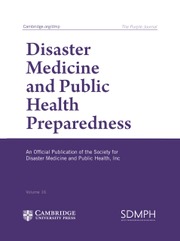Dear Editor,
Michioki Endo et al. reported the challenges of providing continuous care during disasters through a case study of an older woman who developed aspiration pneumonia in an evacuation shelter for the Noto Peninsula earthquake in Japan.Reference Endo, Ozaki and Ikeguchi 1 The death toll from the Noto Peninsula earthquake, which occurred on New Year’s Day 2024, was reported to be 456 as of November 26, 2024, and more than half of them were related to health deterioration after the disaster. 2 Besides the disaster itself, changes in the environment, such as unusual life in evacuation shelters after the disaster, continued to threaten the health of the evacuees. In particular, the toilet problem in evacuation shelters for vulnerable population was serious.
According to a survey of the Noto Peninsula earthquake by the Japan Toilet Labo 3, it took more than 4 days after the disaster for temporary toilets to be installed in 9 of 10 evacuation shelters, and 85% of the temporary toilets were old-fashioned squat toilets with steps, making them difficult for children, older adults, and persons with disabilities with mobility problems to use. In addition, only 2 of the 12 evacuation shelters cleaned their toilets frequently.
Poorly managed toilets increase the risk of spreading infectious diseases.Reference Abney, Bright and McKinney 4 Furthermore, people’s reluctance to use poorly managed or inaccessible toilets leads to restrictions on fluid and food intake, which has a serious impact on their lives and health.Reference Gu, Zhou, Zheng and Huang 5 Japan produces high-quality toilets as a crystallization of advanced technology and hospitality; however, toilets in evacuation shelters during disasters remain a major challenge.
In the event of a disaster, local governments in charge of evacuation shelters will find it difficult to promptly install and manage safe and comfortable toilets due to the sudden increase in disaster-related work and a sudden drop in the number of active staff. It is necessary to stockpile the supplies required for installing safe and comfortable toilets in various locations throughout the community, to promptly send personnel capable of managing them from areas less affected by disasters, and to nationally standardize the entire process from installing to managing them.
Competing interests
KT is a member of the Japan Toilet Labo, a nonprofit organization, and has received honoraria for data analysis and other activities in toilet-related surveys.


